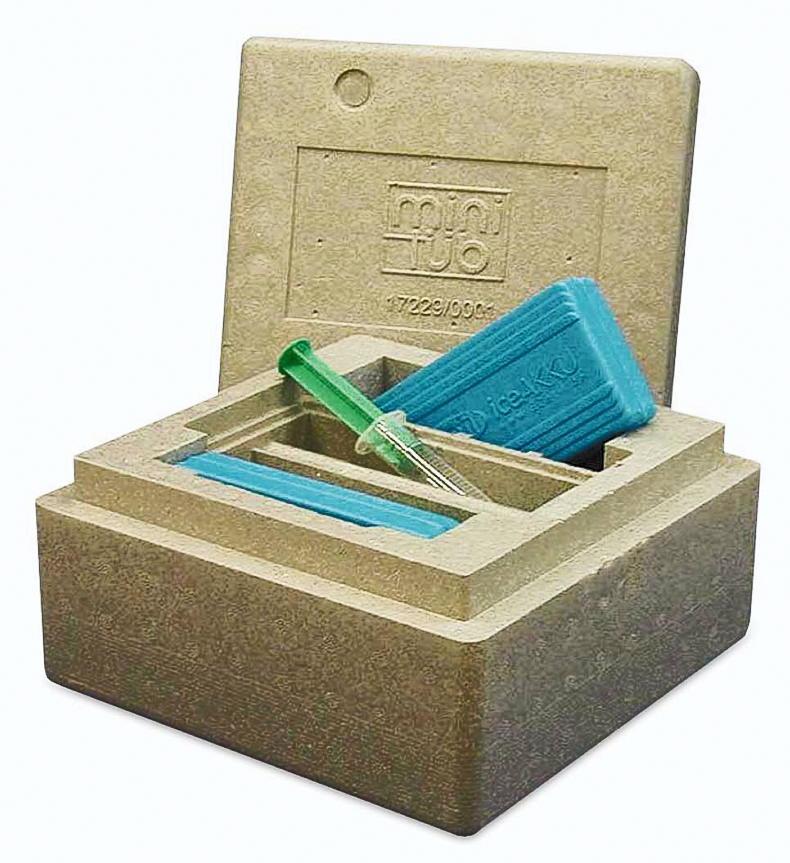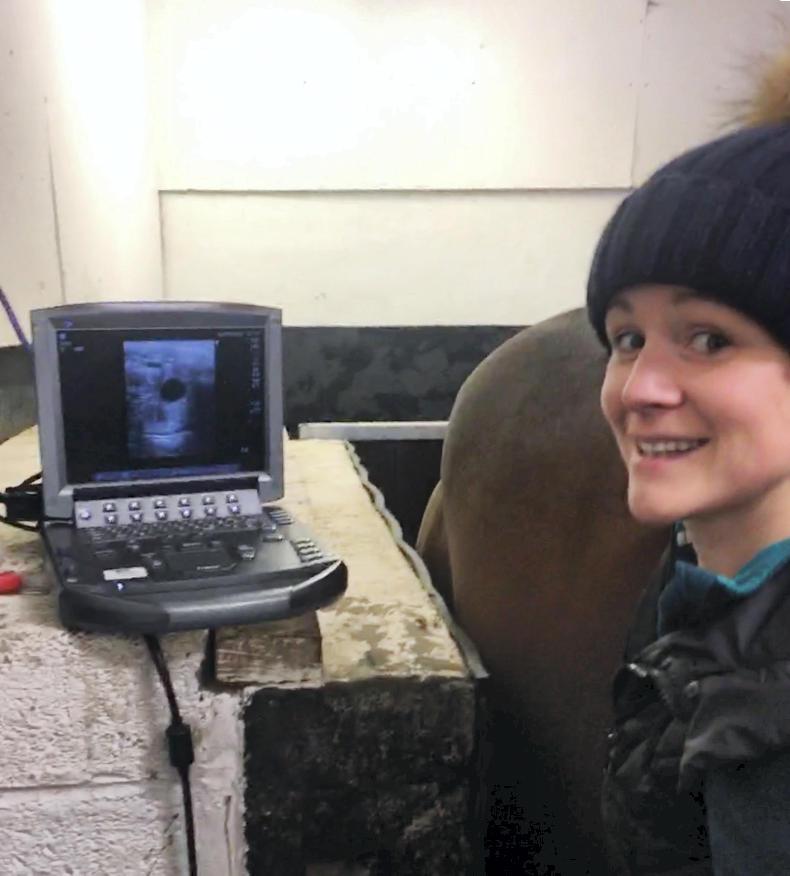Dr Sue Salter set up SES Equine Veterinary Services in 2021 which specialises in equine breeding. Her expanding practice focuses largely on stud medicine and in this time she has developed an excellent reputation across the board for getting mares, particularly the trickier ones, in foal. In this article she provides you with an overview of artificial breeding and pointers to help you choose the right breeding options for your mare.
Chilled semen
Chilled semen may be sourced in Ireland or outside of Ireland depending on your stallion choice. Its arrival normally depends on courier services or An Post. Therefore success is often somewhat dependent on days of collection from the stallion and arrival times of semen to the mare. It is wise to consider the transit times involved.

Timing of giving the ovulation hormone should be considered with respect to transit times and estimated time of arrival of semen \ Alison Corbally FOC
Timing of giving the ovulation hormone should be considered with respect to transit times and estimated time of arrival of semen. Where possible, it is optimum to reduce transit times of semen. For example, collecting semen at depots rather than depending on its arrival via courier to the farm can be advantageous.
Split doses
It is advised not to split doses as the dose, particularly from popular European stallions, has often been calculated at the time of collection and processing to provide you with a dose and number of progressively motile sperm specifically aimed to get your mare in foal. In most cases it has already been split at the time of processing via careful calculation. Often, splitting the dose further will in fact reduce your chance of conception.
Checking the sperm at the time of insemination under the microscope by a qualified veterinarian is advised. Should there have been unforeseen circumstances in transit which could have reduced sperm quality, it is best to know about this at the time of insemination. Always have your mare checked for ovulation by a vet after insemination.
Where possible, have a back-up plan. Considering transit times and the possibility of some chilled semen packages being very unfortunately lost or delayed in transit, it is best to have a back-up plan such as frozen semen immediately available so as not to miss the cycle.
Breeding your mare with frozen semen
Frozen semen doses are normally calculated so as to give a dose of semen containing enough progressively motile sperm available at thaw to get your mare in foal. Therefore, it is strongly advised not to split doses. As with chilled semen, it is a team effort to get a mare in foal. Therefore do not split your team by splitting your dose.
Correct handling of frozen semen is imperative through the process from arrival to the breeding centre to the time of insemination. Deep horn insemination is advised, particularly when provided with a smaller dose (e.g. one straw). Where possible, it is advised to check the sperm quality under the microscope at the time of insemination.

With chilled semen it is wise to consider the transit times involved. \ Istock
Much research exists around the best time for insemination. It is my preference to always perform insemination of frozen semen at or just after ovulation. Since providing frozen AI services, our conception rates are 95%; partly due to using this technique.
Embryo transfer
Our biggest challenge today with respect to embryo transfer is the provision of quality recipients. Our industry is rapidly moving towards oocyte collection (OPU) and intracytoplasmic sperm injection (ICSI) particularly on large farms. The use of these techniques is quickly mopping up available recipients from farms that specialise in providing recipient mares. Freezing of embryos collected via embryo transfer for the small breeder is an excellent option. You may therefore get your mare in foal, have her flushed, freeze the embryo and wait until the right recipient is available to you. Then she can be timed correctly for transfer of the embryo.
When providing your vet with recipient options for transfer, it is best to provide a few. They should be checked via a full reproductive examination with provision of a detailed reproductive history. This will allow the vet to make the best selection of recipient mare, timed correctly to your donor embryo.
If you are new to embryo transfer we suggest that you fully discuss the process itself as well as the costs (also see page 26) involved in the process with your vet.
OPU AND ICSI
In summary, OPU is a technique whereby “eggs” are aspirated from the mare’s ovarian follicles. These unfertilised follicles are then shipped to a centre (presently centres based on mainland Europe) where ICSI is then performed - a technique used to inject the “eggs” with sperm from your chosen stallion. If this entire process is successful then the fertilised egg can be frozen, stored and later placed in a recipient mare.
Mare infertility and stallion infertility are two reasons to consider this technique. Possible complications, like all techniques, should be discussed in detail with your veterinarian. OPU has a higher complication rate than conventional embryo transfer. With OPU comes a higher early pregnancy loss. The technique however can be performed at any time during the mare’s cycle and during transition. Also, unlike with embryo transfer. multiple scans are not necessarily required.
It is possible to gain multiple embryos from one session and it is possible to gain none. Therefore it is imperative to discuss with your vet all potential costs involved in the process.
Dr Sue Salter set up SES Equine Veterinary Services in 2021 which specialises in equine breeding. Her expanding practice focuses largely on stud medicine and in this time she has developed an excellent reputation across the board for getting mares, particularly the trickier ones, in foal. In this article she provides you with an overview of artificial breeding and pointers to help you choose the right breeding options for your mare.
Chilled semen
Chilled semen may be sourced in Ireland or outside of Ireland depending on your stallion choice. Its arrival normally depends on courier services or An Post. Therefore success is often somewhat dependent on days of collection from the stallion and arrival times of semen to the mare. It is wise to consider the transit times involved.

Timing of giving the ovulation hormone should be considered with respect to transit times and estimated time of arrival of semen \ Alison Corbally FOC
Timing of giving the ovulation hormone should be considered with respect to transit times and estimated time of arrival of semen. Where possible, it is optimum to reduce transit times of semen. For example, collecting semen at depots rather than depending on its arrival via courier to the farm can be advantageous.
Split doses
It is advised not to split doses as the dose, particularly from popular European stallions, has often been calculated at the time of collection and processing to provide you with a dose and number of progressively motile sperm specifically aimed to get your mare in foal. In most cases it has already been split at the time of processing via careful calculation. Often, splitting the dose further will in fact reduce your chance of conception.
Checking the sperm at the time of insemination under the microscope by a qualified veterinarian is advised. Should there have been unforeseen circumstances in transit which could have reduced sperm quality, it is best to know about this at the time of insemination. Always have your mare checked for ovulation by a vet after insemination.
Where possible, have a back-up plan. Considering transit times and the possibility of some chilled semen packages being very unfortunately lost or delayed in transit, it is best to have a back-up plan such as frozen semen immediately available so as not to miss the cycle.
Breeding your mare with frozen semen
Frozen semen doses are normally calculated so as to give a dose of semen containing enough progressively motile sperm available at thaw to get your mare in foal. Therefore, it is strongly advised not to split doses. As with chilled semen, it is a team effort to get a mare in foal. Therefore do not split your team by splitting your dose.
Correct handling of frozen semen is imperative through the process from arrival to the breeding centre to the time of insemination. Deep horn insemination is advised, particularly when provided with a smaller dose (e.g. one straw). Where possible, it is advised to check the sperm quality under the microscope at the time of insemination.

With chilled semen it is wise to consider the transit times involved. \ Istock
Much research exists around the best time for insemination. It is my preference to always perform insemination of frozen semen at or just after ovulation. Since providing frozen AI services, our conception rates are 95%; partly due to using this technique.
Embryo transfer
Our biggest challenge today with respect to embryo transfer is the provision of quality recipients. Our industry is rapidly moving towards oocyte collection (OPU) and intracytoplasmic sperm injection (ICSI) particularly on large farms. The use of these techniques is quickly mopping up available recipients from farms that specialise in providing recipient mares. Freezing of embryos collected via embryo transfer for the small breeder is an excellent option. You may therefore get your mare in foal, have her flushed, freeze the embryo and wait until the right recipient is available to you. Then she can be timed correctly for transfer of the embryo.
When providing your vet with recipient options for transfer, it is best to provide a few. They should be checked via a full reproductive examination with provision of a detailed reproductive history. This will allow the vet to make the best selection of recipient mare, timed correctly to your donor embryo.
If you are new to embryo transfer we suggest that you fully discuss the process itself as well as the costs (also see page 26) involved in the process with your vet.
OPU AND ICSI
In summary, OPU is a technique whereby “eggs” are aspirated from the mare’s ovarian follicles. These unfertilised follicles are then shipped to a centre (presently centres based on mainland Europe) where ICSI is then performed - a technique used to inject the “eggs” with sperm from your chosen stallion. If this entire process is successful then the fertilised egg can be frozen, stored and later placed in a recipient mare.
Mare infertility and stallion infertility are two reasons to consider this technique. Possible complications, like all techniques, should be discussed in detail with your veterinarian. OPU has a higher complication rate than conventional embryo transfer. With OPU comes a higher early pregnancy loss. The technique however can be performed at any time during the mare’s cycle and during transition. Also, unlike with embryo transfer. multiple scans are not necessarily required.
It is possible to gain multiple embryos from one session and it is possible to gain none. Therefore it is imperative to discuss with your vet all potential costs involved in the process.












SHARING OPTIONS